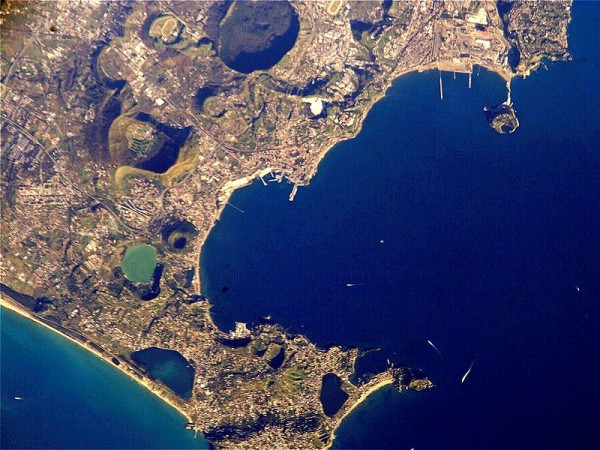By Ana Verayo, | December 23, 2016

Pozzuoli, Campi Flegrei viewed from the International Space Station. (NASA)
The world's deadliest supervolcano might be stirring back to life, with telltale signs appearing from underneath the city of Naples, Italy.
Scientists have detected a very critical pressure point of the supervolcano caldera, Campi Flegrei, which is the first sign in 500 years.
Like Us on Facebook
In this new study, scientists say that this ancient volcano is getting ready for another massive eruption due to rising magma that can trigger volcanic emissions of lava and hot gasses, making it 10 times faster than the usual rate.
Scientists classify a volcano as a supervolcano when it can eject a volume of material of more than 1,000 cubic kilometers which is also more than a thousand times more massive and dense than regular volcanic eruptions.
According to the lead author of the study, Giovanni Chiodini of the National Institute of Geophysics and Volcanology, Rome, this magma surge can produce an injection, releasing hot steam and heating up the surrounding volcanic rocks,
Chiodini explains that these hydrothermal rocks, when heated, can lose some of their mechanical resistance, which can accelerate them into motion and place the volcano under critical conditions. The team warns that this can become "a very dangerous" eruption for the three million locals living in Naples.
The volcano has been undergoing this uplift since 2005, and Campi Flegrei has been collecting magma under its surface since then.
Now, Italian authorities and agencies have raised this threat level from green to yellow, which means that urgent and active monitoring is needed for this supervolcano. Scientists say that this kind of volcano eruption can kill millions of those who are living around the region.
According to Giuseppe De Natale of the Vesuvius Observatory at the Italian National Institute of Geophysics and Volcanology, these regions can result in the most dangerous eruptions that can cause global catastrophe similar to asteroid or meteorite impacts.
The last supervolcano eruption occurred 39,000 years ago and what remains of this is the caldera of Campi Flegrei, forming a depression from the last eruption when the volcano exploded its top. This is also the largest eruption in Europe in the last 200,000 years.
Apart from this caldera, near this region is another active volcano, Pompeii's Mount Vesuvius, which buried Roman armies and settlements and the city itself in 79 C.E.
This new study was published in the journal Nature Communications.
-
Use of Coronavirus Pandemic Drones Raises Privacy Concerns: Drones Spread Fear, Local Officials Say

-
Coronavirus Hampers The Delivery Of Lockheed Martin F-35 Stealth Fighters For 2020

-
Instagram Speeds Up Plans to Add Account Memorialization Feature Due to COVID-19 Deaths

-
NASA: Perseverance Plans to Bring 'Mars Rock' to Earth in 2031

-
600 Dead And 3,000 In The Hospital as Iranians Believed Drinking High-Concentrations of Alcohol Can Cure The Coronavirus

-
600 Dead And 3,000 In The Hospital as Iranians Believed Drinking High-Concentrations of Alcohol Can Cure The Coronavirus

-
COVID-19: Doctors, Nurses Use Virtual Reality to Learn New Skills in Treating Coronavirus Patients







